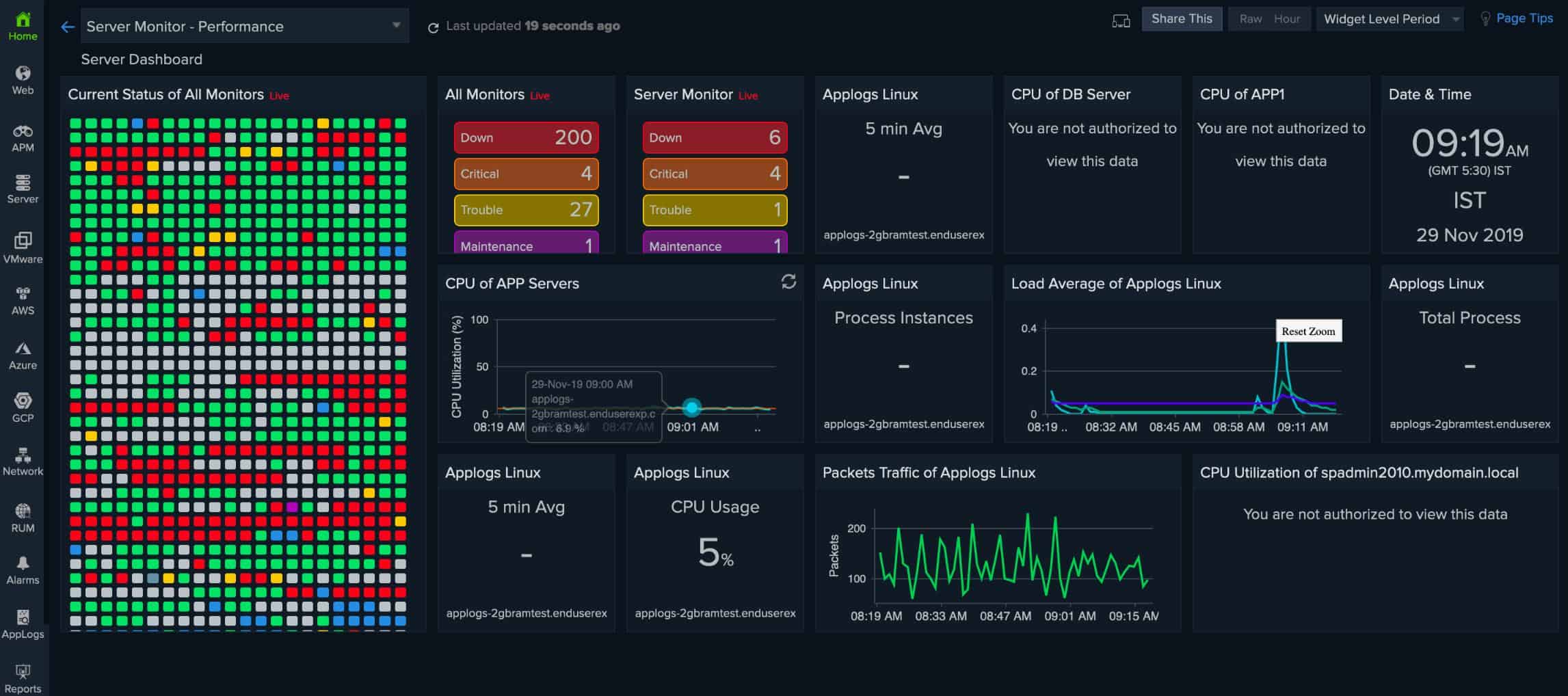We may earn a commission if you make a purchase through the links on our website.
Best Storage Monitoring and Management Tools and Software for SAN and NAS Devices
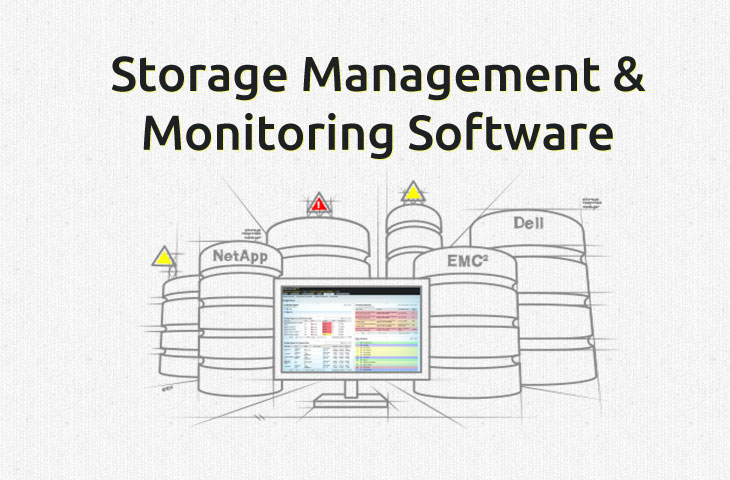
UPDATED: March 18, 2025
Just about every professional and business environment needs storage – whether just for emails and correspondence, or for far more important performance-critical digital applications, websites, hosted files, file servers, exchange servers or SAN Devices – it would be hard to overstate the importance of storage monitoring and management due to this!
Here is our list of the best storage monitoring and management tools:
- Site24x7 Storage Monitoring – FREE TRIAL A monitor for networks, servers, and applications that includes storage device monitoring for both on-premises and cloud resources. This is a cloud-based service. Start a free trial.
- ManageEngine OpManager + Applications Manager – FREE TRIAL Get on-site storage monitoring functions from OpManager and cloud storage monitoring with Applications Manager. Available for Windows Server and Linux. Download a 30-day free trial.
- Nagios XI A system monitoring package that can be expanded by plugins to include the monitoring of storage devices. Installs on Linux.
- IntelliMagic Vision for SAN A performance monitor and capacity planning tool for SAN infrastructure that deploys AI automatic detection of performance bottlenecks, capacity constraints and configuration anomalies. Runs as a cloud service offering.
- SolarWinds Storage Resource Monitor A monitoring system that offers real-time monitoring of a range of brands of storage devices and deploys performance and capacity thresholds that trigger alerts if crossed. Runs on Windows Server.
- AppDynamic Storage Performance Monitoring Part of a wider system monitoring service, the storage monitor that includes root cause analysis and capacity planning facilities. This is a cloud-based system.
- PowerAdmin Storage Monitor A disk usage reporter that includes status alerts and capacity planning assistance. Runs on Windows.
- eG Enterprise Storage Monitoring A storage monitor that is part of a full system monitoring service that is delivered from the cloud.
Both smaller networks simply operating from a NAS-storage basis and larger, multi-network environments running multiple SAN devices need proper monitoring. An untimely outage, failure due to lack of storage, or poor response time due to over-subscription can all cause expensive problems if not downright showstopping failure!
When dealing with managing NAS/SAN storage devices, there's a lot to bear in mind. Software which can monitor capacity, as well as assist in assigning it to various applications, can save a great deal of time and headache by predicting and being aware of needs early on.
Monitoring hardware for failures and outages helps to keep tabs on the physical health of the ever-important storage devices. Keeping track of latency can be one of the best indicators of an aging drive or failing device, while also helping to keep tabs on the management of bandwidth use to and from storage devices.
And of course there's over-subscription, a clever but precarious method for making the most out of your network that works very much in the same vein as overbooking flights like airlines. But it does come with its risks, and software can thankfully help manage those!
Monitoring software needs to be able to keep a close eye on every part of your storage arrangement – whether simple and single systems running as a NAS, or independent SAN devices like tape drives or their ilk. And of course you can't leave LUNs out in the dark. Especially in larger enterprise setups you've got to have robust LUN monitoring and oversight to be sure that your RAIDs are properly allocated and made full use of.
No matter the make-up of your network storage devices, whether Dell, EMC, HP, WD or others, many tools can poll and monitor these devices and even aggregate device-specific data to help keep you, and your network, up to speed.
The Best Storage Management and Monitoring Tools
Our methodology for selecting storage monitoring systems
We reviewed the market for storage monitoring and management tools and analyzed the options based on the following criteria:
- Monitor networks storage and peripheral storage devices
- Performance thresholds for alerts
- Provides trend analysis and capacity planning
- Monitors server disks as well as specialist storage devices
- Combination of application and server monitoring
- Free trial or a demo that allows testing and assessment before buying
- Value for money through cost savings
Below are some of the best options out there for storage monitoring, many of which are paid software suites but do also offer free trials and evaluation versions to make them well worth giving a shot!
1. Site24x7 Storage Monitor – FREE TRIAL
Site24x7 Infrastructure is a system monitoring tool that is delivered from the cloud. The resources that the service monitors can be on-premises or in the cloud. Each monitored system needs an agent program installed on it in order to be enrolled.
Key Features:
- Cloud-Based Monitoring: Delivered from the cloud, offering flexibility and accessibility for organizations of all sizes.
- Comprehensive Device Support: Monitors a wide range of storage devices, including NAS, RAIDs, tape libraries, and fabric switches, regardless of manufacturer.
- Agent-Based Monitoring: Ensures comprehensive coverage of both on-premises and cloud resources through agent program installation.
- Out-of-Box Monitoring Options: Offers a host of out-of-box monitoring options and dashboard templates for storage monitoring, simplifying deployment and configuration.
- Dependency Visualization: Allows administrators to view dependencies within the application stack, facilitating SLA building and uptime optimization.
- Root Cause Analysis Enhanced by AI: Provides root cause analysis enhanced by AI to fix technical issues faster, ensuring efficient issue resolution.
- Multi-Cloud Support: Unifies storage monitoring across multi-cloud environments, providing comprehensive visibility and management.
Why do we recommend it?
Site24x7 Storage Monitor offers comprehensive storage monitoring delivered from the cloud, making it a flexible and accessible solution for organizations. Our evaluation highlights its ability to monitor a wide range of storage devices, including NAS, RAIDs, tape libraries, and fabric switches, regardless of manufacturer. Site24x7's cloud-based approach simplifies deployment, while its agent-based monitoring ensures comprehensive coverage of both on-premises and cloud resources. With features such as out-of-the-box monitoring options, dependency visualization, root cause analysis enhanced by AI, and multi-cloud support, Site24x7 Storage Monitor empowers organizations to optimize uptime, enhance performance, and proactively address storage issues.
The monitoring service starts by discovering all equipment connected to the monitored network, including storage devices. It is able to monitor NAS, RAIDs, tape libraries, and fabric switches regardless of their manufacturers.
The monitor tracks all resources of the storage device, which includes total capacity and used space. The system also tracks performance issues. If performance levels drop or if capacity approaches exhaustion, the system raises an alert. These alerts can be forwarded as notifications to technicians by SMS, email, voice call, or instant messaging post.
Who is it recommended for?
Site24x7 Storage Monitor is recommended for organizations seeking a flexible and feature-rich storage monitoring solution delivered from the cloud. It is particularly suitable for organizations requiring comprehensive monitoring of diverse storage devices across on-premises and cloud environments. Additionally, organizations prioritizing uptime optimization, performance enhancement, and proactive issue resolution will benefit from Site24x7's comprehensive monitoring options, dependency visualization, and AI-driven root cause analysis.
Pros:
- Flexible Cloud-Based Monitoring: Enables organizations to monitor storage resources from anywhere.
- Comprehensive Device Support: Monitors a wide range of storage devices, ensuring compatibility and flexibility for diverse IT environments.
- Out-of-Box Monitoring Options: Simplifies deployment with a host of out-of-box monitoring options and dashboard templates for storage monitoring.
- Dependency Visualization: Facilitates SLA building and uptime optimization by allowing administrators to view dependencies within the application stack.
- Root Cause Analysis Enhanced by AI: Enhances efficiency by providing root cause analysis enhanced by AI to fix technical issues faster.
Cons:
- Learning Curve: Feature-rich platform with options that extend beyond storage management, potentially requiring time to learn all options and features.
Site24x7 Infrastructure costs $9 per month when paid annually. You can start with a free trial.
2. ManageEngine OpManager + Applications Manager – Download Free Trial
ManageEngine offers a suite of system monitoring and management tools. Each module can be used as a standalone system but they are all written on a common platform and interconnect, so combining tools provides extra strength. This is the case with OpManager and Applications Manager. These two utilities combine cover all of your system from applications and websites through to servers and network devices.
Key Features:
- Seamless Integration and Interoperability: Enhanced monitoring capabilities across the entire system.
- Comprehensive Monitoring: Supervises network devices and servers, while Applications Manager focuses on monitoring application performance, ensuring end-to-end visibility and control.
- Autodiscovery and Mapping: Utilizes autodiscovery to find, inventory, and map new devices, simplifying deployment and configuration.
- Intelligent Alerting: Reduces false positives and eliminate alert fatigue, ensuring timely notification of critical issues.
- Multi-Channel Alerting: Supports email, SMS, and webhook for alerting, enabling organizations to receive notifications through various channels.
- Integration with ManageEngine Ecosystem: Integrates well with other ManageEngine products, enhancing overall visibility and management within the ecosystem.
Why do we recommend it?
ManageEngine offers a comprehensive suite of system monitoring and management tools, with OpManager and Applications Manager serving as powerful components that provide enhanced monitoring capabilities. Our evaluation highlights their seamless integration and interoperability, allowing organizations to monitor and manage their entire system, from applications and websites to servers and network devices. OpManager excels in supervising network devices and servers, providing automated performance tracking and status supervision for storage devices such as SAN and NAS systems. On the other hand, Applications Manager focuses on monitoring application performance, ensuring timely data delivery and addressing potential issues before they impact users. Together, OpManager and Applications Manager offer a holistic approach to system monitoring and management, reaching across on-premises and cloud resources to ensure optimal performance and availability.
OpManager was built to supervise network devices and servers. This is a hardware monitoring system that gives you automated performance tracking and status supervision for all storage devices, such as SAN and NAS systems. This tool traces network performance, too, so it can identify if an apparent problem with storage access is really caused by an intermediate device on the path between management software and physical servers.
Storage is not an island, and you will be running applications that make constant, repeated access to those NAS and SAN systems. Applications Manager checks that requested data is delivered up to the application in a timely manner. So you can head off problems before they become noticeable to users by tracking performance of the entire protocol stack up from Layer 2 to Layer 7. The performance of networks, servers, and storage facilities is no longer just a site infrastructure issue. OpManager and Applications Manager reach out across the internet and check on the availability, delivery speeds, and performance of cloud resources as well. While OpManager checks on connections to cloud storage, Applications Manager constantly monitors cloud storage facilities and watches cloud services and server performance.
OpManager and Applications Manager take care of all monitoring tasks automatically. Both systems include an alert mechanism that lets you know when trouble arises. These alerts can be forwarded to you and your team through email and SMS message. That lets you get on with the job of managing resources without having to sit watching system monitoring consoles.
Who is it recommended for?
ManageEngine OpManager + Applications Manager is recommended for organizations seeking a comprehensive system monitoring and management solution with seamless integration and interoperability. It is particularly suitable for organizations requiring end-to-end visibility and control over their IT infrastructure, from network devices and servers to applications and cloud resources. Additionally, organizations prioritizing proactive monitoring, intelligent alerting, and efficient resource management will benefit from OpManager and Applications Manager's feature-rich capabilities and robust alerting mechanisms.
Pros:
- Customizable Dashboards and Reports: Features over 200 customizable widgets to build unique dashboards and reports, providing flexibility and customization options.
- Autodiscovery and Mapping: Utilizes autodiscovery to find, inventory, and map new devices, simplifying deployment and configuration.
- Intelligent Alerting: Reduces false positives and eliminates alert fatigue across larger networks, ensuring timely notification of critical issues.
- Multichannel Alerting: Supports email, SMS, and webhook for alerting, enabling organizations to receive notifications through various channels.
- Integration with ManageEngine Ecosystem: Integrates well with other ManageEngine products, enhancing overall visibility and management within the ecosystem.
Cons:
- Learning Curve for Feature-Rich Tool: Feature-rich tool that may require a time investment to properly learn and leverage its full capabilities.
The software for OpManager and Applications Manager is available for installation on Windows Server and Linux. ManageEngine doesn’t offer a combo of these two services, but buy both and they will slot together. You can put this partnership to the test with a 30-day free trial of OpManager and Applications Manager.
3. Nagios
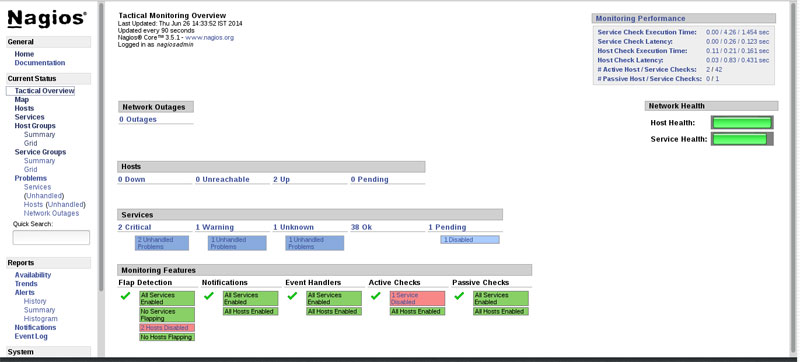
Storage Monitoring with Nagios is a great piece of software that offers a staggering range of flexibility and functionality – mostly due to being highly modular. SAN/NAS and other storage management and monitoring requires additional plugins from the base Nagios software. But once installed, Nagios can more than pull its weight in this regard. Furthermore, as it requires the base Nagios installation, you gain the benefit of having a robust network monitoring suite to begin with.
Key Features:
- Modular Architecture: Provides extensive flexibility and functionality, allowing organizations to customize monitoring according to their specific requirements.
- Comprehensive Monitoring: Covers all essential aspects of storage management, offering versatile monitoring capabilities for SAN/NAS and other storage devices.
- Integration with Base Nagios Installation: Leverages the robust network monitoring suite provided by the base Nagios installation, enhancing overall monitoring capabilities.
- Customization Through Plugins and Addons: Offers flexibility and customization options through plugins and addons, enabling organizations to tailor monitoring to their specific needs.
- Flexible Alerting Options: Supports SMS and email for alerting, providing organizations with flexible alerting options to ensure timely notifications of critical issues.
- Robust API Backend: A great option for developers who want to integrate their own custom applications.
Why do we recommend it?
Nagios Storage Monitoring is a versatile software offering extensive flexibility and functionality, thanks to its highly modular architecture. While additional plugins are required for SAN/NAS and other storage management tasks, Nagios excels in providing comprehensive monitoring capabilities once installed. Moreover, leveraging the base Nagios installation provides the added advantage of a robust network monitoring suite. Nagios covers all essential aspects of storage management and offers customization options through plugins and addons, allowing organizations to tailor monitoring to their specific requirements.
As far as storage management, though, Nagios covers all the bases you'd want, plus gives a lot of flexibility with plugins and addons to customize or change precisely what, or how, you monitor.
Who is it recommended for?
Nagios Storage Monitoring is recommended for organizations seeking a versatile and customizable storage monitoring solution. It is particularly suitable for IT professionals and developers requiring extensive flexibility and functionality in their monitoring tools. Additionally, organizations already utilizing Nagios for network monitoring will find Nagios Storage Monitoring to be a seamless addition, providing comprehensive coverage of storage infrastructure with minimal additional overhead.
Pros:
- Open-Source Transparency: Provides visibility into the underlying codebase and facilitating community contributions.
- Simple Yet Informative Interface: Offers ease of use and accessibility for users of all skill levels.
- Flexible Alerting Options: Supports SMS and email for alerting, ensuring timely notification of critical issues.
- Robust API Backend: Great option for developers who want to integrate their own custom applications, thanks to its robust API backend.
Cons:
- Limited Integrations with Ticketing Systems: Would benefit from additional integrations into more ticketing systems to streamline incident management processes.
- Technical Installation Process: Installation can be technical and complex, potentially requiring IT expertise for setup and configuration.
Free trial, starting at $1,995 and up, some plugins/modules have additional cost/licensing
4. IntelliMagic Vision for SAN
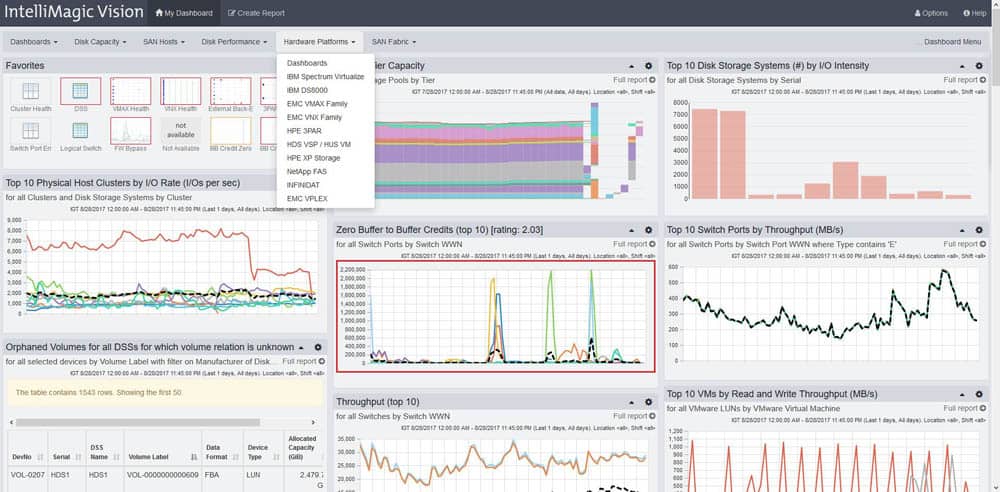
IntelliMagic Vision is a multi-vendor SAN performance, capacity, and configuration analytics solution. It combines deep knowledge of storage array performance and capacity with a deep understanding of end-to-end connectivity.
Key Features:
- End-to-End Visibility: Provides an end-to-end view of the I/O stack, from VMware through the SAN fabric, to storage arrays, facilitating comprehensive analytics and insights.
- AI-Driven Analytics: Leverages AI-driven analytics to continuously monitor performance and configuration health, automatically identifying issues such as storage array performance issues and zoning irregularities.
- Highly-Customizable Admin Dashboard: Enables organizations to tailor reports, compare historical data, and drill down to the most granular level for efficient analysis.
- Interactive and Customizable: Allows users to add and edit favorite reports, compare historical data, and start from a high-level view, enhancing usability and flexibility.
Why do we recommend it?
IntelliMagic Vision for SAN offers a comprehensive solution for SAN performance, capacity, and configuration analytics across multi-vendor environments. Our evaluation highlights its unique capability to provide an end-to-end view of the I/O stack, from VMware through the SAN fabric to storage arrays, enabling organizations to gain insights into their entire storage infrastructure. IntelliMagic's AI-driven analytics continuously monitor performance and configuration health, automatically identifying issues such as storage array performance issues, zoning irregularities, and capacity trends. With its highly-customizable admin dashboard and interactive features, IntelliMagic Vision empowers organizations to optimize their SAN environments efficiently.
While most performance and capacity management solutions focus on either storage support or fabric support or VMware support, IntelliMagic Vision provides an end-to-end picture of the I/O stack from the VMware through the SAN fabric to the storage arrays.
IntelliMagic integrates topology and embeds the configuration relationships in the user interface for intuitive navigation of the configuration and the performance.
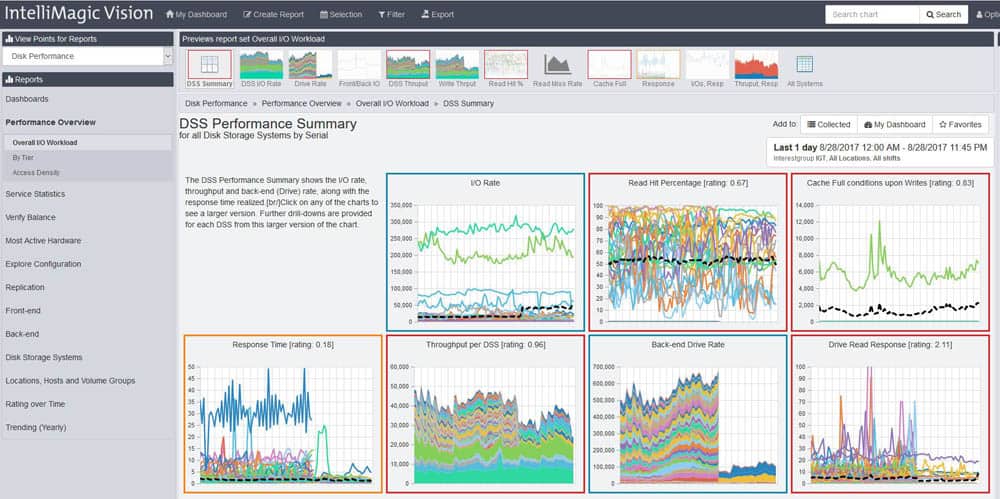
IntelliMagic Vision's AI-driven analytics continuously analyze the performance and configuration health of your multi-vendor SAN environment and automatically identifies issues such as:
- Storage array performance issues such as over-utilized and imbalanced ports and replication delays
- Zoning irregularities such as orphaned ports or hosts with single paths
- Orphaned storage and wasted capacity
- Capacity trending and forecasting
IntelliMagic Vision is interactive and customizable so you can add and edit your favorite reports, start at a 30,000 foot level view and drill down to the most granular level, compare historical data, and more.
Who is it recommended for?
IntelliMagic Vision for SAN is recommended for enterprises and data centers seeking a comprehensive solution for SAN performance, capacity, and configuration analytics. It is particularly suitable for organizations operating multi-vendor SAN environments, requiring deep insights and analytics across their storage infrastructure. Additionally, organizations prioritizing customization and flexibility will benefit from IntelliMagic Vision's highly customizable admin dashboard and interactive features, enabling efficient coordination of storage activities and capacity planning.
Pros:
- Highly Customizable Admin Dashboard: Empowers users to tailor reports and analyze data efficiently.
- Comprehensive SAN Coordination: Coordinates storage activities across multi-vendor environments, enabling organizations to optimize their SAN infrastructure effectively.
- AI-Driven Capacity Planning: Leverages AI to aid in capacity planning, providing valuable insights for optimizing storage resources and infrastructure.
Cons:
- Enterprise and Data Center Focus: While highly effective, IntelliMagic Vision for SAN is better suited for enterprises and data centers, potentially limiting accessibility for smaller organizations with simpler SAN environments.
You can request a free trial and quote.
5. SolarWinds Storage Resource Monitor
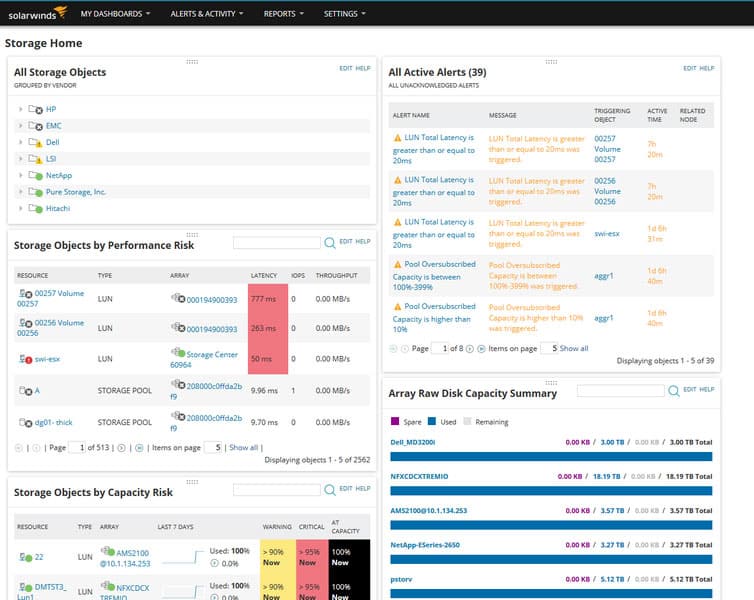
SolarWinds software provides real-time storage monitoring for a range of vendors, all from a slick and comprehensive interface. The program handles a full range of both virtual and physical storage devices and can even delve through the layers of virtualization to fully expose the actual makeup of a storage setup, which can be quite helpful with how confusing virtualization can get when layered as much as it tends to be.
Key Features:
- Multi-Vendor Support: Supports a wide variety of multi-vendor storage options, ensuring compatibility and flexibility for diverse IT environments.
- Automated Capacity Planning: Automatically calculates storage needs for capacity planning, enabling organizations to optimize storage resources efficiently.
- Integration with SolarWinds SAM & VMAN: Integrates well with SolarWinds Server & Application Monitor (SAM) and Virtualization Manager (VMAN), enhancing overall visibility and management of IT infrastructure.
- Comprehensive Performance Monitoring: Offers a variety of performance monitoring options, allowing organizations to monitor storage performance effectively.
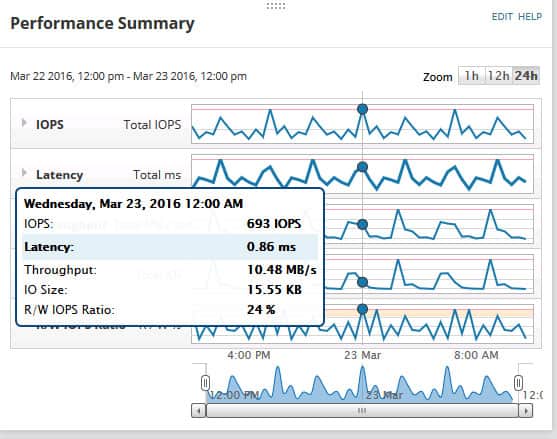
Why do we recommend it?
SolarWinds Storage Resource Monitor (SRM) offers real-time storage monitoring for a variety of vendors, providing organizations with comprehensive insights into their storage infrastructure. Our evaluation underscores its ability to handle both virtual and physical storage devices, including delving into the layers of virtualization to expose the actual makeup of storage setups. SRM's intuitive interface simplifies monitoring tasks, whilst pre-configured alerts and customizable monitoring options ensure basic oversight right out of the box. With support for multi-vendor storage options, automated capacity planning, and integration with SolarWinds SAM & VMAN, SRM is a valuable tool for organizations seeking efficient storage management solutions.
The software also includes a range of pre-configured alerts and monitoring options, which are also customizable, to be sure that basic oversight is taken care of right out of the box.
Who is it recommended for?
SolarWinds Storage Resource Monitor is recommended for small and medium-sized enterprises (SMEs) and larger environments requiring comprehensive storage monitoring solutions. It is particularly suitable for organizations seeking real-time insights into their storage infrastructure across multi-vendor environments. Additionally, organizations utilizing SolarWinds SAM & VMAN will benefit from SRM's seamless integration, enhancing overall visibility and management of their IT infrastructure.
Pros:
- Wide Vendor Support: Supports a wide variety of multi-vendor storage options, ensuring compatibility and flexibility for diverse IT environments.
- Automated Capacity Planning: Automatically calculates storage needs for capacity planning, facilitating efficient resource allocation and optimization.
- Seamless Integration: Integrates well with SolarWinds SAM & VMAN, enhancing overall visibility and management of IT infrastructure.
- Comprehensive Performance Monitoring: Offers a variety of performance monitoring options, enabling organizations to monitor storage performance effectively.
Cons:
- Unsuitable for Smaller Organizations: While highly effective, SolarWinds Storage Resource Monitor is better suited for SMEs and larger environments, potentially lacking some features required by smaller organizations with simpler storage setups.
Start a 30-day free trial.
6. AppDynamics Storage Performance Monitoring
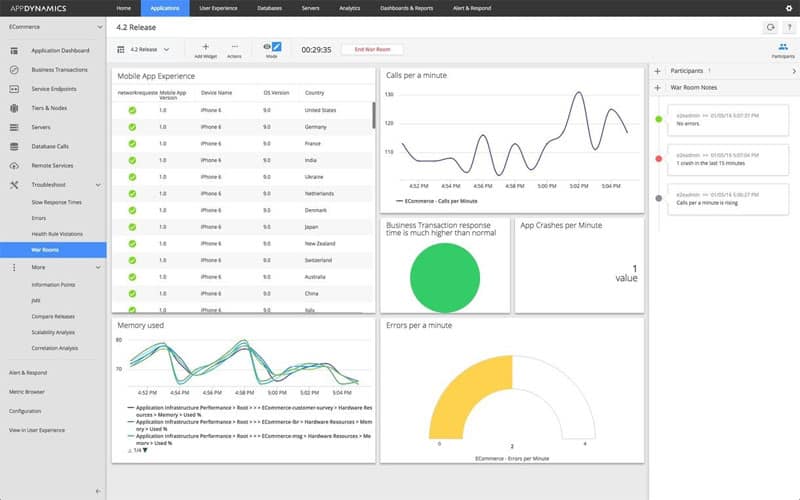
AppDynamics is a very solid “all in one” option that attempts to cover the full range of network-based monitoring and management. With options for everything from application, transactions, services, nodes, servers, database calls, remove services, and of course storage and even more, the program has a staggering range of tracking. This does come with the usual caveat – with breadth comes slightly less depth, and although AppDynamics doesn't suffer as much from this as some software options, you may find some more niche or specific features missing or lacking slightly.
Key Features:
- Comprehensive Monitoring: Offers extensive coverage of various aspects of network monitoring, including applications, transactions, services, servers, and storage.
- Dependency Mapping and Visualizations: Provides excellent dependency mapping and visualizations, enabling organizations to troubleshoot complex application systems effectively.
- Root Cause Analysis Tools: Facilitates incident resolution and operational efficiency.
- Tailored for Large-Scale Enterprise Use: Provides scalability and performance to meet the needs of complex IT environments.
- Free Version Available: Allows organizations to evaluate the platform before making a purchasing decision.
Why do we recommend it?
AppDynamics Storage Performance Monitoring offers a comprehensive “all-in-one” solution for network-based monitoring and management, making it a solid choice for organizations seeking a versatile and integrated monitoring platform. Our evaluation highlights its extensive coverage of various aspects of network monitoring, including applications, transactions, services, servers, and storage. AppDynamics excels in providing excellent dependency mapping and visualizations, facilitating troubleshooting of complex application systems. Additionally, features such as root cause analysis tools enhance incident resolution and operational efficiency.
Who is it recommended for?
AppDynamics Storage Performance Monitoring is recommended for large-scale enterprises requiring comprehensive network monitoring and management capabilities. It is particularly suitable for organizations seeking an integrated solution that covers a wide range of monitoring needs, from applications to storage. Additionally, organizations prioritizing advanced features such as dependency mapping, visualizations, and root cause analysis tools will benefit from AppDynamics' robust capabilities.
Pros:
- Tailored for Large-Scale Enterprise Use: Offers scalability and performance to meet the needs of complex IT environments.
- Excellent Dependency Mapping and Visualizations: Facilitates troubleshooting of complex application systems.
- Free Version Available: Allows organizations to evaluate the platform before making a purchasing decision.
- Root Cause Analysis Tools: Enhances incident resolution and operational efficiency with root cause analysis tools.
Cons:
- Higher Pricing: Priced higher than similar tools on the market, potentially making it less accessible for smaller organizations with limited budgets.
Free trial and demo available, but must contact sales for pricing.
7. PA Storage Monitor
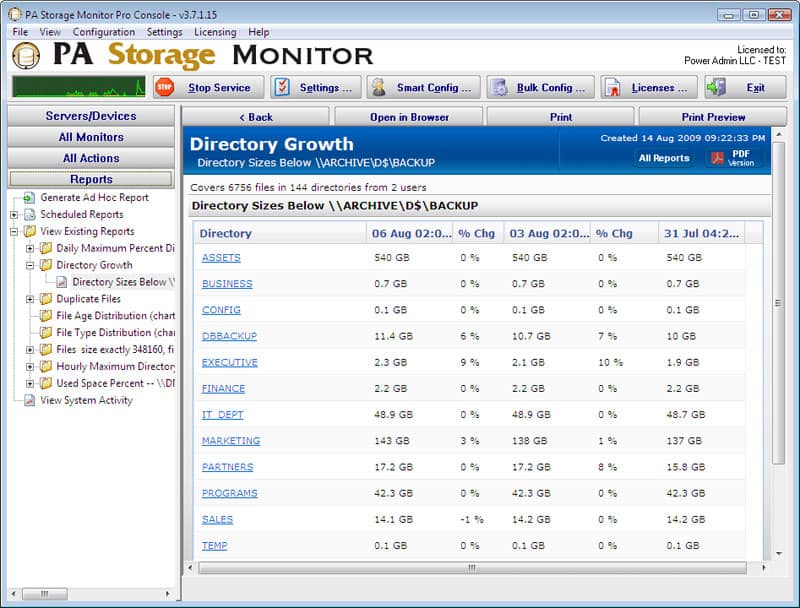
PowerAdmin has a reasonably light-weight and straightforward option that focuses almost exclusively on storage management without many other bells and whistles – which isn't necessarily a bad thing. It scans and catalogs, reports on files, has predictive disk usage, monitoring and alerting, and so forth.
Key Features:
- Lightweight and Straightforward: Focuses primarily on storage management, minimizing system overhead and complexity.
- File and Device Management: Provides comprehensive file management and device management capabilities, catering to organizations with extensive data management requirements.
- Predictive Disk Usage Monitoring: Monitors disk usage proactively, allowing organizations to anticipate and address storage capacity issues before they occur.
- Threshold-Based Alerting: Keeps repeat alarms to a minimum, ensuring timely notifications of critical issues.
- Efficient Resource Utilization: Ensures efficient resource utilization and performance.
Why do we recommend it?
PowerAdmin Storage Monitor offers a lightweight and straightforward solution focused primarily on storage management, making it an ideal choice for organizations prioritizing efficient storage monitoring without unnecessary complexity. Our evaluation highlights its key features, including file management, device management, predictive disk usage monitoring, and alerting capabilities. With a focus on optimizing storage resources and minimizing system overhead, PowerAdmin Storage Monitor provides a solid option for organizations with extensive data management needs.
The focus is more on file management, as well as device management, and would be better used by network environments with a lot of data and space that needs managing, and some of the device managing options fall a little short, but overall it's a solid option.
Who is it recommended for?
PowerAdmin Storage Monitor is recommended for network environments with significant data management requirements, seeking a lightweight and efficient storage monitoring solution. It is particularly suitable for organizations prioritizing file management and device management, with a focus on optimizing storage resources and minimizing system overhead. Additionally, organizations seeking threshold-based alerting and predictive disk usage monitoring will benefit from PowerAdmin's straightforward approach to storage management.
Pros:
- Efficient Resource Utilization: Takes up very little space and system resources, minimizing overhead and optimizing performance.
- Supports Testing Multiple Hosts: Enhances efficiency and scalability.
- Threshold-Based Alerting: Minimizes repeat alarms and ensure timely notification of critical issues.
Cons:
- Opaque Pricing: Requires reaching out to sales for a quote, with pricing not transparent, potentially making it challenging for organizations to assess cost-effectiveness upfront.
A free trial is available. Pricing is $250 and up, with a year of support and maintenance included.
8. EG Innovations
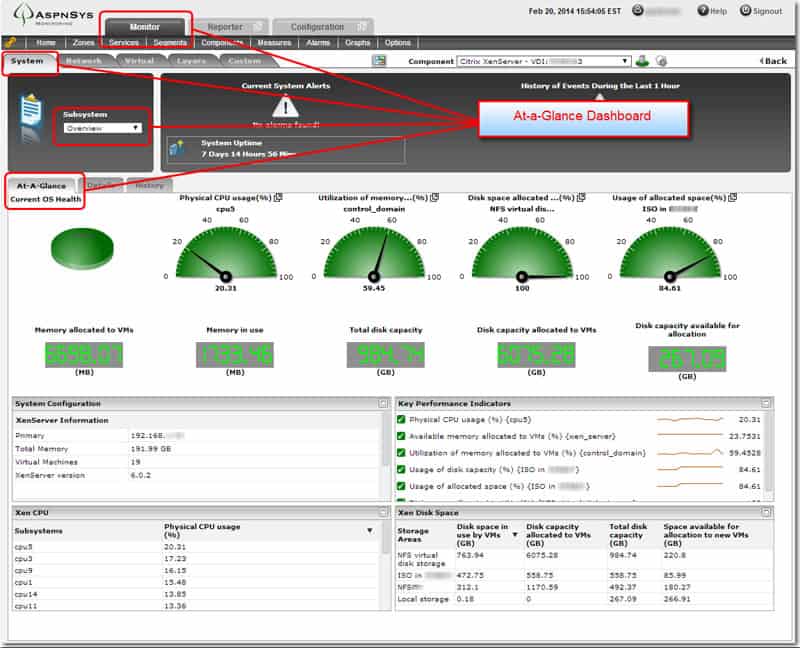
EG Innovations has another program that is a bit more of an “all-in-one” offering that does a good amount of SAN and general network storage monitoring as well.
Key Features:
- Comprehensive Monitoring: Offers comprehensive monitoring of SAN and general network storage, catering to diverse storage environments.
- Reporting and Alerting: Provides strong reporting and alerting capabilities, with a heavy focus on analysis of storage trends and patterns for early troubleshooting and problem prediction.
- Support for Virtual Host Environments: Makes it suitable for organizations with complex storage environments.
- Threshold-Based Alerting: Notifies administrators of VMs going offline or experiencing resource-related issues, ensuring timely incident response.
- Root-Cause Analysis: Helps technical teams solve issues faster and minimize downtime, enhancing overall system uptime and performance.
Why do we recommend it?
EG Innovations offers a comprehensive all-in-one storage monitoring solution, catering to organizations with diverse storage environments and extensive monitoring requirements. Our evaluation highlights its strong focus on reporting, alerting, and analysis, providing organizations with valuable insights into storage trends and patterns for early troubleshooting and problem prediction. With robust support for various virtual host environments and advanced features such as threshold-based alerting and root-cause analysis, EG Innovations Storage Monitoring is well-suited for larger enterprises and MSPs seeking comprehensive storage monitoring capabilities.
The program has a strong focus on reporting and alerting with a heavy amount of analysis on data and storage trends and patterns to aid in early troubleshooting and problem prediction. It handles all ranges of virtualization and does a great job picking apart all the different virtual layers of even the more complex storage environments.
Who is it recommended for?
EG Innovations Storage Monitoring is recommended for larger enterprises and MSPs requiring comprehensive storage monitoring capabilities across diverse virtual host environments. It is particularly suitable for organizations prioritizing reporting, alerting, and analysis to proactively manage storage performance and uptime. Additionally, organizations seeking advanced features such as threshold-based alerting and root-cause analysis will benefit from EG Innovations' robust capabilities.
Pros:
- Wide Range of Virtual Host Environment Support: Monitors a wide range of virtual host environments, making it suitable for larger enterprises or MSPs with diverse infrastructure.
- Threshold-Based Alerting: Notifies administrators of critical issues such as VMs going offline or experiencing performance degradation due to resource-related issues, ensuring timely incident response.
- Root-Cause Analysis: Facilitates faster issue resolution through root-cause analysis, minimizing downtime and optimizing system performance.
Cons:
- No Freeware Version: May limit accessibility for organizations seeking cost-effective monitoring solutions or evaluating the platform before purchase.
Free trial is available, but must contact sales for price.
Storage Monitoring and Management Tools FAQs
What are some popular storage monitoring tools?
Popular storage monitoring tools include SolarWinds Storage Resource Monitor, Nagios, and Datadog.
Can storage monitoring be performed remotely?
Yes, storage monitoring can be performed remotely, allowing administrators to monitor storage systems from a central location.
How does storage monitoring integrate with other IT monitoring tools?
Storage monitoring can integrate with other IT monitoring tools, such as network monitoring software and application performance monitoring software, to provide a comprehensive view of the IT environment.
